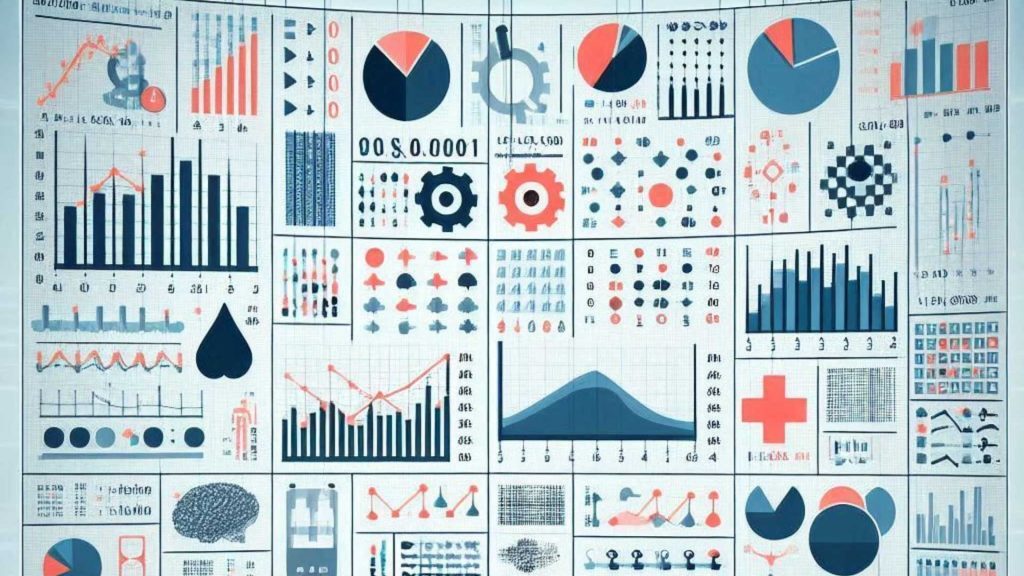Target Audience: This comprehensive overview of probability theory is primarily aimed at students and professionals in the fields of data science, machine learning, and related quantitative disciplines. It covers the fundamental concepts, mathematical foundations, and real-world applications of probability theory, making it a valuable resource for anyone seeking to deepen their understanding of this crucial branch of mathematics.
Value Proposition: By mastering the principles and techniques outlined in this table of contents, readers will gain a robust foundation in probability theory that can be directly applied to a wide range of data-driven problems and decision-making scenarios. From understanding the basics of random variables and probability distributions to exploring advanced topics like Bayesian inference, this resource equips learners with the essential tools and knowledge to excel in their respective fields.
Key Takeaways: The key takeaways from this comprehensive overview of probability theory include a deep understanding of the core concepts and mathematical foundations, the ability to apply probability theory to real-world problems in data science and decision-making, and the confidence to tackle complex challenges involving uncertainty and risk. Readers will also gain exposure to the latest tools and software used for probability calculations, enabling them to effectively leverage these resources in their work.
Probability Theory: Defining Its Fundamental Importance
Probability theory is a fundamental branch of mathematics that holds immense significance for engineering students. This discipline provides a robust mathematical framework for quantifying uncertainty and making informed predictions based on data, which is crucial in the ever-evolving world of engineering.

Practical Applications for Engineering Students
As engineering students delve into the realm of probability theory, they will discover its vast applications across various fields. From modeling random processes in electrical and mechanical systems to evaluating risks in civil engineering projects, probability theory equips students with the necessary tools to navigate the complexities of the engineering landscape.
Enhancing Decision-Making Capabilities
Probability theory empowers engineering students to make well-informed decisions under uncertainty. By understanding the likelihood of different outcomes, students can develop strategies to mitigate risks, optimize system performance, and make data-driven choices that lead to successful project outcomes.
Bridging the Gap Between Theory and Practice
The study of probability theory not only provides a strong theoretical foundation but also offers practical insights that can be directly applied in real-world engineering scenarios. From analyzing the reliability of components in product design to forecasting the behavior of complex systems, probability theory enables engineering students to bridge the gap between classroom learning and industry-relevant problem-solving.
By embracing the principles of probability theory, engineering students can gain a deeper understanding of the uncertainties they will face in their professional careers and develop the analytical skills necessary to navigate them with confidence and success.
Role of Probability Theory in Data Science and Decision-Making
Probability theory is the bedrock upon which data science and informed decision-making are built. As an engineering student, understanding the pivotal role of probability in these domains is crucial for your success.
The Centrality of Probability in Data Science
Probability theory is the foundation for a wide range of statistical methods and machine learning algorithms employed in data science. It enables data scientists to quantify and manage uncertainty, a critical aspect of working with real-world data.
Key applications of probability in data science include:
- Predictive Modeling: Probability distributions and statistical inference techniques are used to develop and validate predictive models, allowing data scientists to forecast future outcomes with greater accuracy.
- Hypothesis Testing: Probability theory underpins the statistical methods used to test hypotheses and draw meaningful conclusions from data.
- Model Evaluation: Probability-based metrics, such as ROC curves and AUC, are used to assess the performance of machine learning models and ensure their reliability.
By mastering the principles of probability, engineering students can unlock the full potential of data science, leveraging its power to drive innovation and make informed, evidence-based decisions.
Probability and Decision-Making
In the business world, probability theory is a crucial tool for effective decision-making. It allows organizations to assess risks, optimize strategies, and make choices backed by data rather than gut instinct.
Some key applications of probability in decision-making include:
- Scenario Analysis: Probability models are used to analyze the potential outcomes of future events, enabling businesses to plan for various contingencies.
- Sales Forecasting: Probability distributions are employed to estimate future revenue generation, informing production, investment, and other strategic decisions.
- Risk Evaluation: Probability is used to calculate the expected value of potential outcomes, allowing businesses to make informed choices about risks and opportunities.
As an engineering student, understanding how to apply probability theory to decision-making processes will give you a competitive edge, empowering you to contribute to data-driven, strategic decision-making in your future career.
Probability theory equips engineering students with the essential skills to thrive in data science and strategic decision-making. By understanding the principles of probability, students can harness the power of data-driven insights to drive innovation and make informed choices that lead to success. Mastering probability theory positions students for rewarding careers at the forefront of data science, where they can navigate the uncertainties of the real world with confidence and expertise.
Probability Theory: Foundational Concepts and Principles
Probability is the study of the likelihood of events occurring. It involves understanding sample spaces, events, probability axioms, and probability distributions. Mastering these concepts enables students to analyze data, make informed decisions, and model uncertainty in various fields.
Sample Space and Events
The sample space is the set of all possible outcomes of a random experiment, while events are subsets of the sample space. The sample space can be finite or infinite, discrete or continuous, depending on the nature of the experiment. Events can be simple (single outcome) or compound (combination of outcomes). Understanding the sample space and events is foundational for calculating probabilities.
Example:
Imagine you are rolling a six-sided die. The sample space, SSS, consists of all possible outcomes: S={1,2,3,4,5,6}S = \{1, 2, 3, 4, 5, 6\}S={1,2,3,4,5,6}
A simple event could be rolling a 4: E={4}E = \{4\}E={4}
A compound event could be rolling an even number: E={2,4,6}E = \{2, 4, 6\}E={2,4,6}
- Sample Space (S): {1, 2, 3, 4, 5, 6}
- Simple Event: {4}
- Compound Event: {2, 4, 6}
Probability Axioms (Additive, Multiplicative)
Probability axioms are the basic rules that govern the calculation of probabilities, ensuring consistency and logical coherence.
- Additive Axiom: For mutually exclusive events, the probability of their union is the sum of their probabilities.
Example:
If you have two mutually exclusive events, A and B, where A is rolling a 1 and B is rolling a 2: P(A)=16P(A) = \frac{1}{6}P(A)=61 P(B)=16P(B) = \frac{1}{6}P(B)=61 P(A∪B)=P(A)+P(B)=16+16=26=13P(A \cup B) = P(A) + P(B) = \frac{1}{6} + \frac{1}{6} = \frac{2}{6} = \frac{1}{3}P(A∪B)=P(A)+P(B)=61+61=62=31
- Multiplicative Axiom: For independent events, the probability of their intersection is the product of their probabilities.
Example:
If you roll a die and flip a coin, the outcomes are independent. Let A be rolling a 4 and B be flipping a heads: P(A)=16P(A) = \frac{1}{6}P(A)=61 P(B)=12P(B) = \frac{1}{2}P(B)=21 P(A∩B)=P(A)×P(B)=16×12=112P(A \cap B) = P(A) \times P(B) = \frac{1}{6} \times \frac{1}{2} = \frac{1}{12}P(A∩B)=P(A)×P(B)=61×21=121
Probability Distributions and Random Variables
Probability distributions describe how probabilities are distributed over the possible values of a random variable, which can be discrete or continuous.
Random Variables: Variables that take on different values based on the outcome of a random phenomenon.
- Discrete Distributions: Defined for countable outcomes, such as the binomial and Poisson distributions.
Example:
Binomial Distribution: Suppose you flip a coin 3 times and count the number of heads. The random variable XXX can take on values 0, 1, 2, or 3. The probability distribution is given by the binomial formula: P(X=k)=(nk)pk(1−p)n−kP(X = k) = \binom{n}{k} p^k (1-p)^{n-k}P(X=k)=(kn)pk(1−p)n−k
For a fair coin (p=0.5p = 0.5p=0.5): P(X=0)=(30)(0.5)0(0.5)3=0.125P(X = 0) = \binom{3}{0} (0.5)^0 (0.5)^3 = 0.125P(X=0)=(03)(0.5)0(0.5)3=0.125 P(X=1)=(31)(0.5)1(0.5)2=0.375P(X = 1) = \binom{3}{1} (0.5)^1 (0.5)^2 = 0.375P(X=1)=(13)(0.5)1(0.5)2=0.375 P(X=2)=(32)(0.5)2(0.5)1=0.375P(X = 2) = \binom{3}{2} (0.5)^2 (0.5)^1 = 0.375P(X=2)=(23)(0.5)2(0.5)1=0.375 P(X=3)=(33)(0.5)3(0.5)0=0.125P(X = 3) = \binom{3}{3} (0.5)^3 (0.5)^0 = 0.125P(X=3)=(33)(0.5)3(0.5)0=0.125
Pictorial Representation:
- X | P(X)
- —-|—–
- 0 | 0.125
- 1 | 0.375
- 2 | 0.375
- 3 | 0.125
- Continuous Distributions: Defined for uncountable outcomes, such as the normal and exponential distributions.
Example:
Normal Distribution: Heights of people can be modeled by a normal distribution with a mean μ\muμ and standard deviation σ\sigmaσ.
Pictorial Representation:
- ^
- | _
- | / \
- | / \
- | / \
- |____/_________________\____>
- μ – 3σ μ μ + 3σ
In this representation, most data falls within three standard deviations (σ) of the mean (μ).
Understanding these foundational concepts in probability equips you with the tools to analyze and interpret random phenomena, making it essential for fields ranging from statistics to engineering and beyond.

Types of Probability: An Engaging Guide for Students
Probability is a fundamental concept in statistics and mathematics that helps us understand and quantify uncertainty. This guide will walk you through different types of probability with clear explanations, practical examples, and helpful visuals.
1. Marginal Probability: Marginal probability is the probability of a single event occurring without considering any other events. It helps us understand the behavior of individual variables in a joint distribution.
Formula: Marginal probability can be calculated by summing or integrating the probabilities of all possible values of other variables.
Example: Consider a deck of 52 playing cards. The marginal probability of drawing an Ace (regardless of the suit) is: P(Ace)=Number of AcesTotal Number of Cards=452=113P(\text{Ace}) = \frac{\text{Number of Aces}}{\text{Total Number of Cards}} = \frac{4}{52} = \frac{1}{13}P(Ace)=Total Number of CardsNumber of Aces=524=131
2. Conditional Probability: Conditional probability is the probability of one event occurring given that another event has already occurred. It is crucial for understanding dependencies between events.
Formula: P(A∣B)=P(A∩B)P(B)P(A|B) = \frac{P(A \cap B)}{P(B)}P(A∣B)=P(B)P(A∩B) Where P(B)>0P(B) > 0P(B)>0
Example: In a classroom of 30 students, 10 are girls, and 5 of those girls are wearing glasses. The probability that a student is wearing glasses given that the student is a girl is: P(Glasses∣Girl)=P(Glasses∩Girl)P(Girl)=5/3010/30=510=0.5P(\text{Glasses}|\text{Girl}) = \frac{P(\text{Glasses} \cap \text{Girl})}{P(\text{Girl})} = \frac{5/30}{10/30} = \frac{5}{10} = 0.5P(Glasses∣Girl)=P(Girl)P(Glasses∩Girl)=10/305/30=105=0.5
3. Joint Probability: Joint probability is the probability of two or more events occurring simultaneously. It helps analyze the relationship between multiple variables.
Formula: P(A∩B)P(A \cap B)P(A∩B)
Example: Using the same classroom example, the probability that a student is both a girl and wearing glasses is: P(Girl∩Glasses)=530=16P(\text{Girl} \cap \text{Glasses}) = \frac{5}{30} = \frac{1}{6}P(Girl∩Glasses)=305=61
4. Bayes’ Theorem: Bayes’ theorem relates conditional probabilities and provides a method for updating probabilities based on new evidence. It is fundamental for Bayesian inference.
Formula: P(A∣B)=P(B∣A)P(A)P(B)P(A|B) = \frac{P(B|A)P(A)}{P(B)}P(A∣B)=P(B)P(B∣A)P(A)
Example: Suppose a test for a disease has a 99% sensitivity (true positive rate) and a 99% specificity (true negative rate). If 1% of the population has the disease, the probability that a person has the disease given a positive test result can be calculated using Bayes’ theorem: P(Disease∣Positive)=P(Positive∣Disease)P(Disease)P(Positive)P(\text{Disease}|\text{Positive}) = \frac{P(\text{Positive}|\text{Disease})P(\text{Disease})}{P(\text{Positive})}P(Disease∣Positive)=P(Positive)P(Positive∣Disease)P(Disease)
Given:
- P(Positive∣Disease)=0.99P(\text{Positive}|\text{Disease}) = 0.99P(Positive∣Disease)=0.99
- P(Disease)=0.01P(\text{Disease}) = 0.01P(Disease)=0.01
- P(Positive)=P(Positive∣Disease)P(Disease)+P(Positive∣No Disease)P(No Disease)=(0.99×0.01)+(0.01×0.99)=0.0198P(\text{Positive}) = P(\text{Positive}|\text{Disease})P(\text{Disease}) + P(\text{Positive}|\text{No Disease})P(\text{No Disease}) = (0.99 \times 0.01) + (0.01 \times 0.99) = 0.0198P(Positive)=P(Positive∣Disease)P(Disease)+P(Positive∣No Disease)P(No Disease)=(0.99×0.01)+(0.01×0.99)=0.0198
So, P(Disease∣Positive)=0.99×0.010.0198≈0.5P(\text{Disease}|\text{Positive}) = \frac{0.99 \times 0.01}{0.0198} \approx 0.5P(Disease∣Positive)=0.01980.99×0.01≈0.5
Understanding these types of probability is essential for various fields, including statistics, machine learning, and risk assessment. By grasping marginal, conditional, and joint probabilities, and Bayes’ theorem, you can better analyze and interpret data in practical situations. Keep exploring these concepts with real-world examples and visual aids to deepen your comprehension and application skills.
Probability Distributions: Discrete Probability Distributions
1. Bernoulli Distribution: The Bernoulli distribution represents the probability of a single binary outcome, such as a coin toss, which results in either head (success) or tails (failure). This distribution is defined by a single parameter ppp, the probability of success.
Example:
- Coin Toss: If we toss a fair coin, p=0.5p = 0.5p=0.5 for heads and 1−p=0.51 – p = 0.51−p=0.5 for tails.
- Exam Question: If a student has a 70% chance of correctly answering a multiple-choice question, p=0.7p = 0.7p=0.7 and 1−p=0.31 – p = 0.31−p=0.3.
Applications: Used in binary classification problems and Bernoulli trials.
2. Binomial Distribution: The binomial distribution models the number of successes in a fixed number of independent Bernoulli trials. It is defined by two parameters: nnn (number of trials) and ppp (probability of success).
Probability Mass Function: P(X=k)=(nk)pk(1−p)n−kP(X = k) = \binom{n}{k} p^k (1-p)^{n-k}P(X=k)=(kn)pk(1−p)n−k
Example:
- Quality Control: In a factory, if there is a 5% defect rate in produced items and we inspect 20 items, the binomial distribution can model the number of defective items found.
- Survey Analysis: In a survey, if 60% of respondents are expected to favor a policy and we survey 100 people, the binomial distribution can predict the number of favorable responses.
Applications: Quality control, survey analysis, biological experiments.
3. Poisson Distribution: The Poisson distribution models the number of events occurring in a fixed interval of time or space, given a constant mean rate (λ\lambdaλ).
Probability Mass Function: P(X=k)=λke−λk!P(X = k) = \frac{\lambda^k e^{-\lambda}}{k!}P(X=k)=k!λke−λ
Example:
- Queuing Theory: Number of customers arriving at a bank in an hour.
- Telecommunications: Number of emails received per minute.
Applications: Queuing theory, telecommunications, reliability engineering.
Continuous Probability Distributions
1. Normal Distribution: The normal distribution describes a continuous random variable with a symmetric, bell-shaped distribution, characterized by its mean (μ\muμ) and standard deviation (σ\sigmaσ).
Probability Density Function: f(x)=1σ2πe−(x−μ)22σ2f(x) = \frac{1}{\sigma \sqrt{2\pi}} e^{-\frac{(x-\mu)^2}{2\sigma^2}}f(x)=σ2π1e−2σ2(x−μ)2
Example:
- Measurement Errors: Heights of people, test scores.
- Natural Phenomena: Distribution of IQ scores.
Applications: Measurement errors, natural phenomena, financial modeling.
2. Exponential Distribution: The exponential distribution models the time between events in a Poisson process, with a constant hazard rate (λ\lambdaλ).
Probability Density Function: f(x)=λe−λxf(x) = \lambda e^{-\lambda x}f(x)=λe−λx
Example:
- Survival Analysis: Time until a radioactive particle decays.
- Reliability Engineering: Time between failures of a machine.
Applications: Survival analysis, reliability engineering, queuing theory.
3. Uniform Distribution: The uniform distribution describes a continuous random variable that has equal probability over a specified interval [a, ba, ba,b].
Probability Density Function: f(x)=1b−a for a≤x≤bf(x) = \frac{1}{b-a} \text{ for } a \leq x \leq bf(x)=b−a1 for a≤x≤b
Example:
- Simulation: Random number generation.
- Monte Carlo Methods: Random sampling from a specified range.
Applications: Simulation, random sampling, Monte Carlo methods.
Understanding these probability distributions helps in analyzing various real-world phenomena, from simple coin tosses to complex financial models. By mastering these concepts, students can gain valuable insights into the patterns and behaviors of different types of data.
Properties of Probability Distributions
Understanding the properties of probability distributions is essential in statistics and various real-world applications. Key properties include the mean (expected value), variance, skewness, and kurtosis. Let’s explore these with examples and visual aids to make them more engaging and practical.

Mean (Expected Value) and Variance:
Mean (Expected Value): The mean, or expected value, represents the central tendency of a probability distribution. It tells us where the average value of a random variable lies.
For discrete variables: E(X)=∑xP(x)E(X) = \sum x P(x)E(X)=∑xP(x)
For continuous variables: E(X)=∫xf(x) dxE(X) = \int x f(x) \, dxE(X)=∫xf(x)dx
Example: Consider rolling a fair six-sided die. The possible outcomes are 1, 2, 3, 4, 5, and 6, each with a probability of 16\frac{1}{6}61.
E(X)=1⋅16+2⋅16+3⋅16+4⋅16+5⋅16+6⋅16=3.5E(X) = 1 \cdot \frac{1}{6} + 2 \cdot \frac{1}{6} + 3 \cdot \frac{1}{6} + 4 \cdot \frac{1}{6} + 5 \cdot \frac{1}{6} + 6 \cdot \frac{1}{6} = 3.5E(X)=1⋅61+2⋅61+3⋅61+4⋅61+5⋅61+6⋅61=3.5
Variance: The variance measures the dispersion or spread of a distribution, indicating how much the values of a random variable deviate from the mean.
Var(X)=E[(X−E(X))2]\text{Var}(X) = E[(X – E(X))^2]Var(X)=E[(X−E(X))2]
Example: Using the die example, we calculate the variance as follows:
- First, find the squared deviations from the mean: (1−3.5)2,(2−3.5)2,(3−3.5)2,(4−3.5)2,(5−3.5)2,(6−3.5)2(1 – 3.5)^2, (2 – 3.5)^2, (3 – 3.5)^2, (4 – 3.5)^2, (5 – 3.5)^2, (6 – 3.5)^2(1−3.5)2,(2−3.5)2,(3−3.5)2,(4−3.5)2,(5−3.5)2,(6−3.5)2 6.25,2.25,0.25,0.25,2.25,6.256.25, 2.25, 0.25, 0.25, 2.25, 6.256.25,2.25,0.25,0.25,2.25,6.25
- Then, multiply each by the probability 16\frac{1}{6}61 and sum: Var(X)=16(6.25+2.25+0.25+0.25+2.25+6.25)=2.92\text{Var}(X) = \frac{1}{6}(6.25 + 2.25 + 0.25 + 0.25 + 2.25 + 6.25) = 2.92Var(X)=61(6.25+2.25+0.25+0.25+2.25+6.25)=2.92
Skewness and Kurtosis
Skewness: Skewness measures the asymmetry of a probability distribution. A distribution can be:
- Symmetric: Skewness = 0
- Positively skewed (right-skewed): Skewness > 0
- Negatively skewed (left-skewed): Skewness < 0
Example: Income distribution in a country is often positively skewed, with a few people earning much higher than the average.
Kurtosis: Kurtosis measures the “tailedness” of the distribution, indicating the presence of outliers. Types of kurtosis:
- Mesokurtic: Kurtosis ≈ 3 (normal distribution)
- Leptokurtic: Kurtosis > 3 (more outliers, sharper peak)
- Platykurtic: Kurtosis < 3 (fewer outliers, flatter peak)
Example: Stock market returns often exhibit leptokurtic behavior due to extreme movements.
Moments of Distributions: Moments are quantitative measures related to the shape of a distribution. They include:
- First moment (Mean): Measures central tendency
- Second moment (Variance): Measures dispersion
- Third moment (Skewness): Measures asymmetry
- Fourth moment (Kurtosis): Measures tailedness
Higher-order moments provide deeper insights into the distribution’s shape and behavior.
Example: In financial modeling, understanding higher-order moments helps in assessing risk and extreme events.
Understanding these properties—mean, variance, skewness, and kurtosis—provides a comprehensive view of probability distributions. They are fundamental for summarizing data and are crucial for further statistical analysis and decision-making. By grasping these concepts, students can better interpret and analyze data in various fields, from economics to engineering.
Statistical Independence: Two events are independent if the occurrence of one does not affect the probability of the other occurring. Mathematically, events A and B are independent if: P(A∩B)=P(A)⋅P(B)P(A \cap B) = P(A) \cdot P(B)P(A∩B)=P(A)⋅P(B)
Independence simplifies the analysis of joint distributions and the calculation of probabilities. It is crucial for many statistical methods, including hypothesis testing and model assumptions.
Examples of Independent Events
Description: Practical examples help illustrate the concept of independent events and their significance in probability theory.
- Rolling Two Dice: The outcome of rolling one die does not affect the outcome of rolling another die. For example, rolling a 4 on the first die does not influence the probability of rolling a 3 on the second die. Mathematically: P(First die is 4∩Second die is 3)=P(First die is 4)⋅P(Second die is 3)=16⋅16=136P(\text{First die is 4} \cap \text{Second die is 3}) = P(\text{First die is 4}) \cdot P(\text{Second die is 3}) = \frac{1}{6} \cdot \frac{1}{6} = \frac{1}{36}P(First die is 4∩Second die is 3)=P(First die is 4)⋅P(Second die is 3)=61⋅61=361
- Flipping Multiple Coins: Each coin flip is independent of the others. If you flip a coin twice, the probability of getting heads on the first flip and tails on the second flip is: P(Heads on 1st flip∩Tails on 2nd flip)=P(Heads on 1st flip)⋅P(Tails on 2nd flip)=12⋅12=14P(\text{Heads on 1st flip} \cap \text{Tails on 2nd flip}) = P(\text{Heads on 1st flip}) \cdot P(\text{Tails on 2nd flip}) = \frac{1}{2} \cdot \frac{1}{2} = \frac{1}{4}P(Heads on 1st flip∩Tails on 2nd flip)=P(Heads on 1st flip)⋅P(Tails on 2nd flip)=21⋅21=41
- Selecting Cards from a Shuffled Deck Without Replacement: While this example involves some subtlety, selecting cards with replacement ensures independence. For instance, drawing a King and then drawing an Ace with replacement: P(King first∩Ace second)=P(King first)⋅P(Ace second)=452⋅452=1169P(\text{King first} \cap \text{Ace second}) = P(\text{King first}) \cdot P(\text{Ace second}) = \frac{4}{52} \cdot \frac{4}{52} = \frac{1}{169}P(King first∩Ace second)=P(King first)⋅P(Ace second)=524⋅524=1691
Understanding independence helps in designing experiments and interpreting results. Independence is a key assumption in many probabilistic models and statistical tests.
Conditional Probability and Independence
Conditional probability measures the likelihood of an event occurring given that another event has occurred. Independence exists when the occurrence of one event does not affect the probability of another event.
Conditional Probability and Its Applications
Conditional probability quantifies the likelihood of an event given that another event has occurred. The formula is: P(A∣B)=P(A∩B)P(B)P(A|B) = \frac{P(A \cap B)}{P(B)}P(A∣B)=P(B)P(A∩B)
Applications:
- Medical Diagnosis: Estimating the probability of a disease given a positive test result.
- Risk Assessment: Calculating the likelihood of an event given prior occurrences.
- Machine Learning: Updating model predictions based on new data.
Conditional probability helps in updating beliefs and making decisions based on new information.
Testing for Independence
Testing for independence involves determining whether two events or variables are statistically independent. Methods include hypothesis testing, correlation analysis, and contingency tables.
Applications:
- Feature Selection in Machine Learning: Identifying independent features improves model performance.
- Causality Studies: Determining if one variable influences another.
- Network Analysis: Understanding the independence of nodes in a network.
Example: Hypothesis Testing for Independence Consider a study to test if smoking is independent of lung disease. You collect data and create a contingency table:
| Lung Disease | No Lung Disease | Total | |
| Smoker | 90 | 60 | 150 |
| Non-Smoker | 30 | 120 | 150 |
| Total | 120 | 180 | 300 |
Using the chi-square test for independence, you calculate the expected frequencies and compare them to the observed frequencies to determine if there is a significant association between smoking and lung disease.
Bayesian Probability
Bayesian probability is a method of statistical inference that updates the probability of a hypothesis as new evidence or information becomes available. It provides a framework for incorporating prior knowledge and updating beliefs based on observed data, allowing for more informed decision-making.
Bayesian Inference and Its Principles
Bayesian inference is a method of statistical inference that updates the probability of a hypothesis as more evidence becomes available. This is based on Bayes’ theorem.
- Key Concept: It involves calculating posterior probabilities by combining prior beliefs with the likelihood of observed data.
- Flexibility: Provides a flexible framework for updating knowledge and making predictions.
- Applications: Widely used in machine learning, data analysis, and decision-making under uncertainty.
Example: Suppose you are trying to determine whether it will rain tomorrow. You start with a prior belief based on weather patterns (e.g., a 30% chance of rain). As you observe new data, such as weather forecasts or humidity levels, you update this belief to form a posterior probability.

Prior and Posterior Distributions
Prior and posterior distributions represent initial and updated beliefs about a parameter in Bayesian analysis.
- Prior Distribution: Reflects the initial state of knowledge before observing data.
- Posterior Distribution: Combines the prior distribution with the likelihood of observed data, representing updated beliefs.
Example: If you’re estimating the average height of students in a class, your prior distribution could be based on the known average heights of students in similar classes. After measuring some students, you update this distribution to form the posterior distribution.
Applications of Bayesian Methods in Data Science
Bayesian methods are powerful tools for modeling uncertainty, making predictions, and inferring relationships in data science.
- Applications: Bayesian networks, hierarchical models, and Markov Chain Monte Carlo (MCMC) methods.
- Fields: Natural language processing, computer vision, and recommendation systems.
- Benefits: Provides robust and interpretable results, especially in complex and uncertain environments.
Example: In recommendation systems, Bayesian methods can continuously update recommendations based on user feedback.
Applications of Probability Theory
Probability theory finds widespread applications across various domains, enabling informed decision-making, risk assessment, and optimization. From finance and insurance to medical diagnosis and quality control, probability theory provides a framework for quantifying uncertainty and making data-driven choices.
Real-World Examples and Case Studies
Probability theory is applied in numerous real-world scenarios to model uncertainties, make predictions, and inform decisions.
Examples:
- Weather Forecasting: Using probabilistic models to predict the likelihood of different weather conditions.
- Stock Market Analysis: Assessing the probabilities of stock price movements to inform trading strategies.
- Epidemiological Studies: Estimating the spread of diseases and the effectiveness of interventions.
Case Study: A detailed example of how probability models are used in weather forecasting, including data collection, model construction, and validation.
Applications in Data Science, Machine Learning, and Decision-Making
Probability theory is foundational to data science and machine learning, providing the mathematical framework for various algorithms and techniques.
Examples:
- Supervised and Unsupervised Learning: Probability is used to build models that can classify data or find hidden patterns.
- Anomaly Detection: Identifying unusual patterns that do not conform to expected behavior.
- Pattern Recognition: Recognizing patterns and making predictions based on probabilistic models.
Probability Theory in Data Science
Probability theory is the backbone of data science, enabling the quantification of uncertainty and the development of robust statistical models for data analysis and prediction. By mastering the principles of probability, data scientists can extract meaningful insights from complex datasets, make informed decisions, and drive innovation across various domains.
Importance of Probability in Data Science Workflows
Probability theory enables robust statistical analysis and model development in data science workflows.
Key Points:
- Data Preprocessing: Handling missing data and outliers using probabilistic methods.
- Exploratory Data Analysis: Using probability to summarize data and make inferences.
- Hypothesis Testing: Making decisions based on probabilistic evidence.
Applications in Predictive Modeling and Uncertainty Estimation
Probability theory enhances predictive modeling by quantifying uncertainty and providing probabilistic interpretations of model outputs.
Examples:
- Regression and Classification: Estimating probabilities and predicting outcomes.
- Bootstrapping and Cross-Validation: Assessing model performance and uncertainty.
- Confidence and Prediction Intervals: Constructing intervals to quantify uncertainty in predictions.
Challenges and Limitations
While probability theory provides a powerful framework for data analysis, it also faces challenges in data science. Limitations include the need for accurate data, assumptions, and the inability to establish causality. Nonetheless, probability remains a crucial tool for extracting insights from complex datasets.
Assumptions and Limitations of Probability Theory
Applying probability theory involves certain assumptions that may not always hold in real-world data, leading to limitations.
Key Assumptions:
- Independence: Assumes that events are independent of each other.
- Identical Distribution: Assumes data is identically distributed.
- Large Sample Sizes: Assumes large sample sizes for reliable inferences.
Limitations: Model misspecification, overfitting, and non-stationarity in data can affect results.
Challenges in Applying Probability Theory to Complex Problems
Real-world problems often present challenges that complicate the application of probability theory.
Key Challenges:
- High-Dimensional Data: Managing data with many variables.
- Non-Linearity: Handling non-linear relationships.
- Dependencies: Accounting for dependencies among variables.
Solution: Requires advanced methods and computational techniques, emphasizing the need for interdisciplinary approaches and domain knowledge.
Tools and Software for Probability Theory
To explore and apply probability theory, students can leverage a variety of software tools, including spreadsheet programs, statistical software, and specialized probability calculators. These user-friendly platforms enable students to perform probability calculations, simulate random experiments, and visualize probability distributions, enhancing their understanding and problem-solving abilities.
Overview of Tools and Software Used for Probability Calculations
Various tools and software facilitate probability calculations and statistical analysis, essential for data science and research.
- Python:
- Libraries: NumPy, SciPy, Pandas, and PyMC3 are powerful libraries used for probabilistic programming and Bayesian analysis.
- Example: Use NumPy to generate random samples, SciPy to fit probability distributions, and PyMC3 for Bayesian inference.
- Visual Representation: Graphs of distributions generated using Matplotlib.
- R:
- Packages: Stats, MCMCpack, and brms are widely used for comprehensive probability and statistical modeling.
- Example: Use the stats package to perform hypothesis testing, MCMCpack for Markov Chain Monte Carlo simulations, and brms for Bayesian regression models.
- Visual Representation: Use ggplot2 to create detailed plots of statistical models.
- Excel:
- Functions and Add-ins: Excel’s built-in functions and add-ins enable basic probability calculations and data analysis.
- Example: Use Excel functions like NORM.DIST for normal distribution probabilities and Data Analysis Toolpak for descriptive statistics.
- Visual Representation: Utilize Excel charts and histograms for data visualization.
Features and Capabilities for Performing Probability Analysis
Modern statistical software offers robust features for analyzing and simulating probability distributions.
- Parameter Estimation: Estimate parameters of probability distributions using maximum likelihood or Bayesian methods.
- Example: Use Python’s SciPy to estimate the parameters of a normal distribution.
- Visual Representation: Plot the fitted distribution against the observed data.
- Hypothesis Testing: Conduct tests to determine if sample data supports a specific hypothesis.
- Example: Perform a t-test in R using the t.test function.
- Visual Representation: Visualize the test statistic distribution and critical regions.
- Simulation Studies: Simulate random variables to understand their behavior under different scenarios.
- Example: Use Monte Carlo simulations in Python with NumPy.
- Visual Representation: Display simulation results with histograms and scatter plots.
- Visualization of Distributions: Tools for creating detailed plots of probability distributions.
- Example: Use R’s ggplot2 to visualize probability density functions (PDFs) and cumulative distribution functions (CDFs).
- Visual Representation: Create plots showing PDF and CDF with shaded areas representing probabilities.
- Bayesian Inference: Perform Bayesian analysis to update probabilities based on new evidence.
- Example: Use PyMC3 in Python to perform Bayesian inference.
- Visual Representation: Plot posterior distributions and credible intervals.
Types of Random Variables in Probability Distribution
Random variables in probability distributions can be classified as discrete or continuous. Discrete random variables take on a countable set of values, while continuous random variables can take on any value within a specified range. Understanding the distinction between these types of random variables is crucial for selecting the appropriate probability distribution and conducting accurate statistical analyses.
Definition and Classification of Random Variables
Random variables are variables whose values result from random phenomena, classified into discrete and continuous types.
- Discrete Random Variables: Take on countable values, such as integers.
- Example: Number of heads in coin tosses.
- Visual Representation: Probability mass function (PMF) plots showing probabilities at each possible value.
- Continuous Random Variables: Take on uncountable values, typically intervals on the real number line.
- Example: Heights, weights.
- Visual Representation: Probability density function (PDF) plots showing density over intervals.
Examples of Discrete and Continuous Random Variables
Examples illustrate the practical differences between discrete and continuous random variables.
- Discrete Examples:
- Number of defective items in a batch.
- Number of goals in a match.
- Number of students in a class.
- Visual Representation: Use bar plots to show the probability of each discrete value.
- Continuous Examples:
- Time taken to complete a task.
- Temperature measurements.
- Length of a part produced.
- Visual Representation: Use histograms and density plots to show the distribution of continuous values.
Cumulative Probability Distribution
The cumulative probability distribution function (CDF) represents the probability that a random variable takes a value less than or equal to a given value. It provides a comprehensive view of the probability distribution, enabling students to analyze the likelihood of outcomes and make informed decisions.
Definition and Calculation of Cumulative Probability
Cumulative probability refers to the probability that a random variable takes on a value less than or equal to a specific value, represented by the cumulative distribution function (CDF).
- Discrete Random Variable: For a discrete random variable XXX, the cumulative probability is P(X≤x)P(X \leq x)P(X≤x).
- Example: Calculate the cumulative probability of getting at most 3 heads in 5 coin tosses.
- Visual Representation: Plot the CDF with steps showing cumulative probabilities.
- Continuous Random Variable: A continuous random variable, it is found by integrating the probability density function (PDF) up to the specified value.
- Example: Calculate the cumulative probability of a height being less than 170 cm.
- Visual Representation: Plot the CDF as a smooth curve.
Cumulative Distribution Function (CDF) and Its Significance
The CDF is a fundamental tool in probability theory, describing the cumulative probability of a random variable up to a given point.
- Definition: The CDF FX(x)F_X(x)FX(x) is defined as P(X≤x)P(X \leq x)P(X≤x) for a random variable XXX.
- Example: Use the CDF to determine the probability of a random variable being within a certain range.
- Visual Representation: Show how the CDF reaches 1 as the variable approaches its maximum value.
- Significance: The CDF provides a complete description of the distribution of a random variable.
- Example: Calculate quantiles and perform various statistical tests using the CDF.
- Visual Representation: Use cumulative plots to illustrate probability over intervals.

Conclusion
Summary of Key Concepts in Probability Theory
A recap of the fundamental concepts and applications of probability theory in data science and statistical analysis.
- Overview:
- Basic probability concepts, including sample space, events, and probability axioms.
- Importance of probability distributions and their applications in real-world scenarios.
- Key properties of distributions, statistical independence, Bayesian methods, and challenges in applying probability theory.
Future Trends and Advancements in Probability Theory and Its Applications
Emerging trends and future directions in probability theory, driven by advancements in technology and data science.
- Machine Learning Integration: Increasing integration of machine learning with traditional probabilistic methods.
- New Algorithms and Tools: Development of new algorithms and tools for handling complex and high-dimensional data.
- Emphasis on Interpretability: Growing emphasis on interpretability, robustness, and ethical considerations in probabilistic modeling and analysis.
- Visual Representation: Diagrams showing the intersection of machine learning and probability, new algorithms’ workflows, and examples of ethical considerations in data science.
Trizula’s Mastery in Data Science is the perfect fit for aspiring professionals. It equips them with the necessary fundamentals in contemporary technologies such as data science, laying the groundwork for advanced fields like AI, ML, NLP, and deep science. Our program is committed to empowering the current IT student community with essential skills aligned with their academic pursuits at an affordable cost. Click here to get started and seize this opportunity to become job-ready by the time you graduate.
FAQs:
1. How is probability theory used in data science?
Probability theory is fundamental to data science, providing the mathematical foundation for concepts like statistical inference, machine learning, and predictive modeling. It allows data scientists to quantify uncertainty, make accurate predictions, and draw meaningful insights from complex datasets.
2. What are the types of probability in data science?
The main types of probability used in data science include:
- Conditional probability: The probability of an event given the occurrence of another event.
- Bayesian probability: The probability of an event based on prior knowledge and new evidence.
- Frequentist probability: The probability of an event based on the frequency of its occurrence.
3. What is the probability theory?
Probability theory is the mathematical study of uncertainty, randomness, and probability. It provides a framework for quantifying the likelihood of events, modeling random phenomena, and making informed decisions in the face of incomplete information.
4. What is the probability function in data science?
In data science, probability functions are mathematical models that describe the distribution of probabilities over the possible values of a random variable. Common examples include the normal distribution, binomial distribution, and Poisson distribution, which are used to model various types of data and make probabilistic inferences.
5. What are the rules of probability in data science?
The fundamental rules of probability in data science include:
- The addition rule: The probability of the union of two mutually exclusive events is the sum of their probabilities.
- The multiplication rule: The probability of the intersection of two independent events is the product of their probabilities.
- The complement rule: The probability of an event not occurring is one minus the probability of the event occurring.



